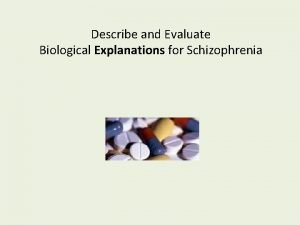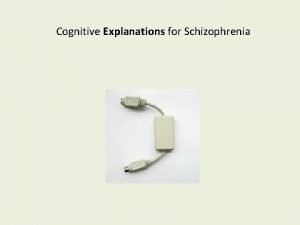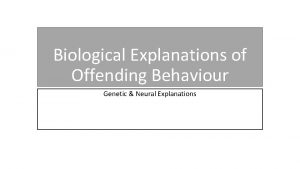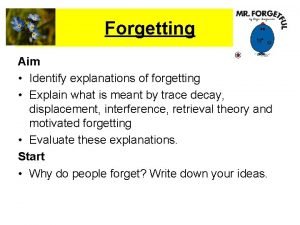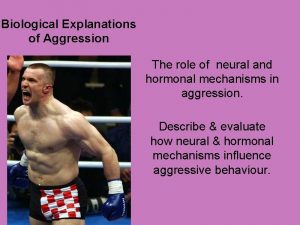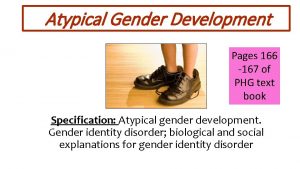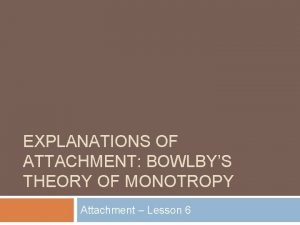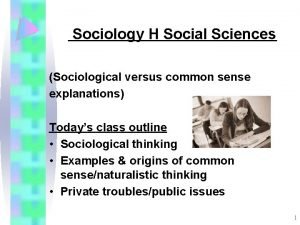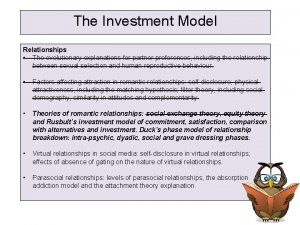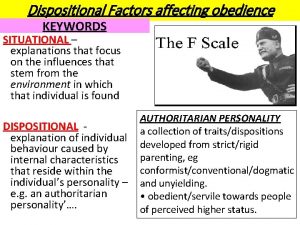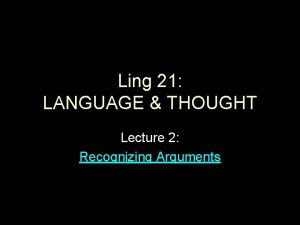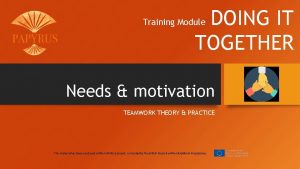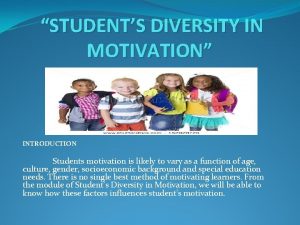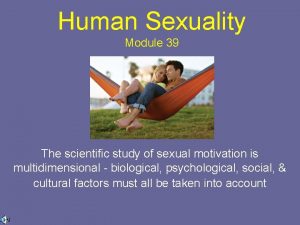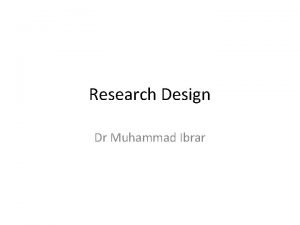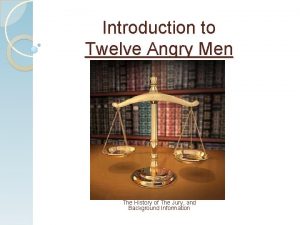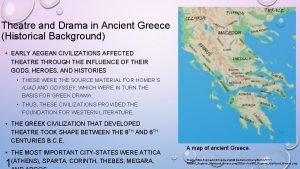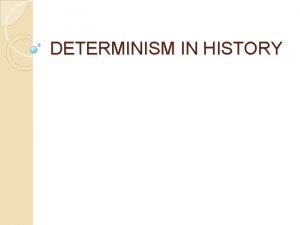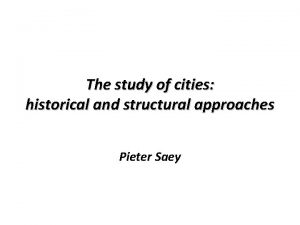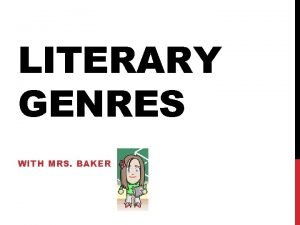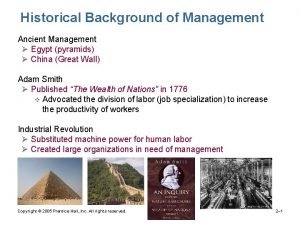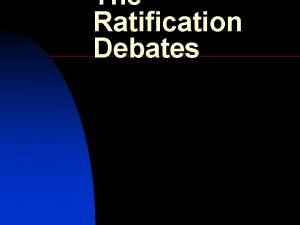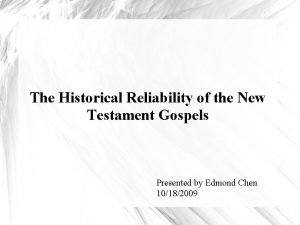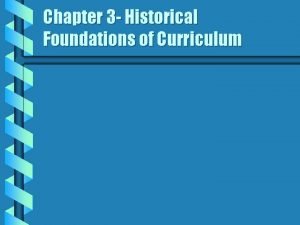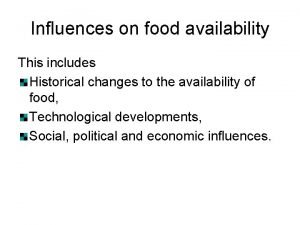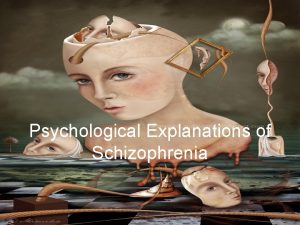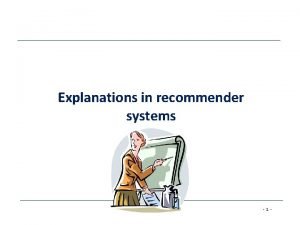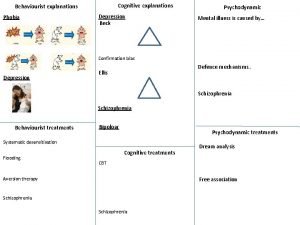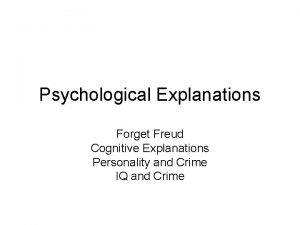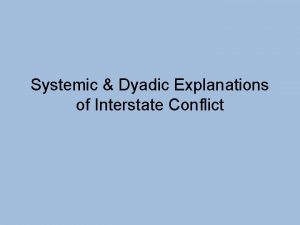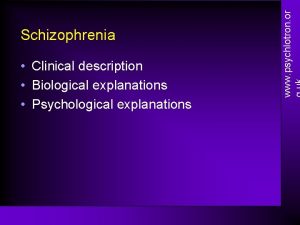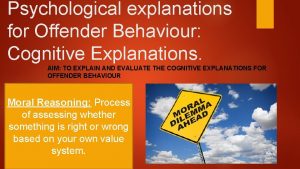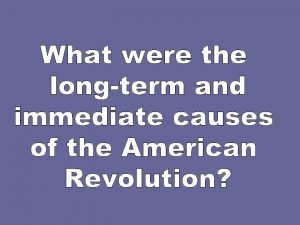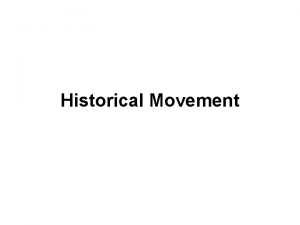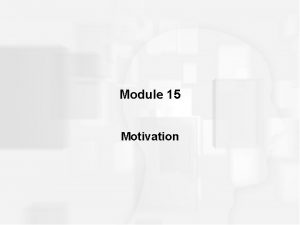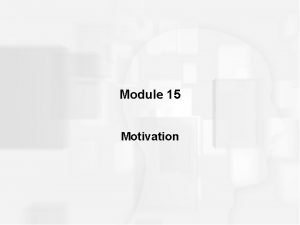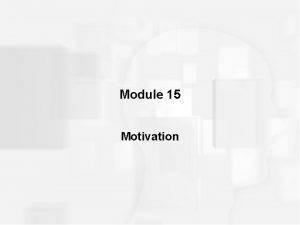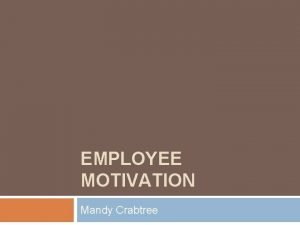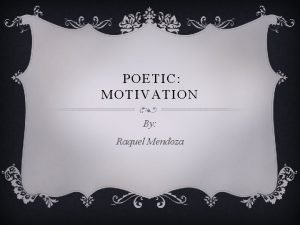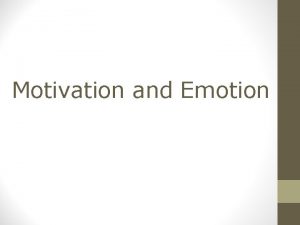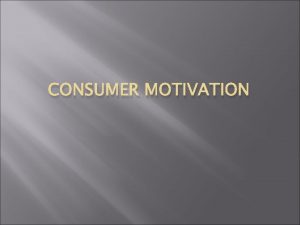Module 26 Motivation Module 26 Motivation Historical Explanations







































- Slides: 39

Module 26 Motivation

Module 26: Motivation Historical Explanations: Instincts

Instinct • A complex, inherited, behavior that is rigidly patterned throughout a species. • William James listed 37 instincts. • Difficulty using instincts to both label and explain behaviors

Drives • Aroused tension states created by imbalances • Prompt an organism to restore the balance, typically reducing the drive • Part of drive-reduction theory

Drive-Reduction Theory • The idea that a physiological need creates a state of tension state (a drive) that motivates an organism to satisfy the need. • Eating and drinking are examples of drive-reducing behaviors.

Drive-Reduction Theory

Module 26: Motivation Biological Explanations: Arousal Theories

Arousal • Levels of alertness and responsiveness

Yerkes-Dodson Law • The theory that a degree of psychological arousal helps performance, but only to a point. • Optimum level of arousal depends on the difficulty of the task. • Each person has an optimum level of stimulation they like to maintain.

Yerkes-Dodson Law

Module 26: Motivation Biological Explanations: Homeostasis

Homeostasis • A tendency to maintain a balanced or constant internal state. • The regulation of any aspect of body chemistry, such as blood glucose, around a particular level • Any change in levels, up or down, results in being motivated to bring the level back to normal.

Homeostatic Regulation

Module 26: Motivation Cognitive Explanations

Extrinsic Motivation • A desire to perform a behavior because of promised rewards or threats of punishment.

Intrinsic Motivation • A desire to perform a behavior for its own sake and to be effective.

Module 26: Motivation Clinical Explanations: Hierarchy of Needs

Abraham Maslow (1908 -1970) • Humanistic psychologist who proposed the hierarchy of needs, with self-actualization as one of the ultimate psychological needs.

Hierarchy of Needs • Maslow’s pyramid of human needs, beginning at the base with physiological needs that must be satisfied before higher-level safety needs and then physiological needs become active. • Continually higher-level needs won’t become active until lower-level needs have been satisfied.

Self-Actualization • According to Maslow, an ultimate psychological need that arises after basic physical and psychological needs are met and self-esteem is achieved; • the motivation to realize our full and unique potential.

Maslow’s Hierarchy of Needs

Module 26: Motivation Clinical Explanations: Achievement Motivation

Henry Murray (1893 -1988) • Neo-Freudian who first established the concept of achievement motivation and developed important personality testing tools.

Achievement Motivation • A desire for significant accomplishment; • for the mastery of things, people, or ideas; and • for attaining a high standard.

Module 26: Motivation Hunger: A Closer Look: Physiology of Hunger

Glucose • Form of sugar which circulates through the body • One feels hunger when the levels become low.

Insulin • Hormone which allows the body to use glucose for energy or fat production • As insulin levels increase, glucose levels decrease.

Leptin • Protein produced by bloated fat cells • Send a message to “stop eating”

Orexin • Hunger-triggering hormone • Produced by the hypothalamus • As glucose levels drop, orexin levels increase and person feels hungry

Hypothalamus • Regulates appetite • Monitors leptin levels

Set Point • The point at which an individual’s “weight thermostat” is supposedly set; • when the body falls below this weight, an increased hunger and a lowered metabolic rate may act to restore the lost weight.

Basal Metabolic Rate (BMR) • The body’s resting rate at which we burn calories for energy.

Module 26: Motivation Hunger: A Closer Look: Environment and Hunger

External Incentives • Include the sight, sound, and smell of food

Cultural Influences on Eating • Cultural views on obesity can vary • Culture influences the foods we like and dislike.

Module 26: Motivation Hunger: A Closer Look: Eating Disorders

Anorexia Nervosa • An eating disorder in which normal-weight people (usually in adolescent females) have a distorted self-perception of being “fat, ” put themselves of self-starvation regimens, and become dangerously underweight (15 percent or more below normal).

Anorexia Nervosa • Anorexics put themselves on selfstarvation regimens • May become dangerously underweight (15% of more below normal)

Bulimia Nervosa • An eating disorder characterized by episodes of overeating – • usually of high-calorie foods • followed by vomiting, use of laxatives, fasting, or excessive exercise.
 Diathesis stress model
Diathesis stress model Cognitive explanations of schizophrenia
Cognitive explanations of schizophrenia Neural explanations of offending behaviour
Neural explanations of offending behaviour Explanations for forgetting
Explanations for forgetting Biological explanations of aggression
Biological explanations of aggression Dust bowl migration map
Dust bowl migration map Gender dysphoria biological explanations
Gender dysphoria biological explanations Monotropy definition
Monotropy definition Russian revolution cartoons
Russian revolution cartoons Common sense and sociological explanations
Common sense and sociological explanations The investment model of relationships
The investment model of relationships Outline two explanations for obedience
Outline two explanations for obedience Outline and compare two explanations for offending 16 marks
Outline and compare two explanations for offending 16 marks Arguments and explanations
Arguments and explanations Motivation training module
Motivation training module Students diversity in motivation
Students diversity in motivation Module 39 sexual motivation
Module 39 sexual motivation C device module module 1
C device module module 1 Meaning of research design
Meaning of research design 12 angry men historical context
12 angry men historical context Pride and prejudice historical context
Pride and prejudice historical context Historical background of greece
Historical background of greece Historical determinism
Historical determinism Death of a salesman historical context
Death of a salesman historical context Trace the history of community development in tanzania
Trace the history of community development in tanzania Literary approaches
Literary approaches George bernard shaw ppt
George bernard shaw ppt Questions about genres of literature
Questions about genres of literature Ancient management egypt pyramid
Ancient management egypt pyramid Historical embeddedness
Historical embeddedness Background information on to kill a mockingbird
Background information on to kill a mockingbird Historical research examples
Historical research examples Historical context of federalist #10
Historical context of federalist #10 Historical narrative meaning
Historical narrative meaning Reliability of new testament
Reliability of new testament An inspector calls historical context
An inspector calls historical context Background information on the outsiders
Background information on the outsiders Renaissance masks history
Renaissance masks history Historical foundations of curriculum
Historical foundations of curriculum Food availability in australia
Food availability in australia
